Featured Application
This paper focuses on new knowledge obtained from the first-ever flight-tested vertical take-off and landing turboelectric unmanned aircraft, providing initial data and guidance for future hybrid gas-electric, manned, and unmanned aircraft.
Abstract
This paper evaluates the performance and practical challenges associated with fabricating and flight testing an unmanned aircraft powered by a turboelectric system based on a 7 kW turbine engine. Emerging hybrid gas-electric aircraft concepts have been the subject of numerous design studies and analytical evaluations; however, there is a critical need to identify and assess practical issues associated with integrating a hybrid turboelectric power system into an aircraft. The purpose of this study, relevant to emerging hybrid-powered aircraft, is to evaluate and retrofit a prototype turboelectric power system to an existing 391 N gross take-off weight unmanned airframe. The representative 7 kW turboelectric system was installed to identify challenges and to formulate data-driven recommendations for general application to urban air mobility. This work addresses performance, power and thermal management, vibration, and acoustic emissions. Results include a weight breakdown with the turboelectric system making up 21% of the total aircraft weight, in-flight voltage and current measurements with maximum loads observed during a dive pull-out, temperature measurements, accelerometer measurements, and far field sound pressure level measurements. Practical recommendations from this study are applicable to power system reliability, electronic component selection, cooling requirements, and peak power behavior, informing the design of future hybrid gas–electric aircraft.
1. Introduction
A turboelectric system is a hybrid gas–electric power system in which a gas turbine engine is used to create shaft work to drive an electric generator. The power produced by this turbogenerator is often augmented with a battery to improve operability and increase power density. Power from the turboelectric system and batteries are used to power electric motors for aircraft propulsion. Since the number and placement of electric motors is variable, aircraft designers have the freedom to distribute thrust across the airframe without a substantial increase in mechanical complexity. This can be utilized to increase the propulsive efficiency of an aircraft and thus reduce the amount of fuel burned. For this reason, numerous researcher engineers at the National Aeronautics and Space Administration (NASA) have been working on commercial aircraft scale turboelectric systems [1,2,3]. Work has begun on constructing a Megawatt scale superconducting generator–motor for a future turboelectric aircraft test rig [4]. Notably, work has also been done over several years on the 224 kW Hybrid-Electric Integrated Systems Testbed (HEIST) [5]. This testbed can be operated using a turboelectric system and facilitates research focusing on utilizing distributed propulsion. This testbed does not fly, but rather, it is attached to a large truck to simulate different airspeeds. There have been many conceptual and analytical studies done to evaluate designs and predict performance for turboelectric transport aircraft, but there is a critical need for a sub-scale, unmanned demonstrator aircraft to safely identify and evaluate practical integration challenges, which is the aim of this current study. Subsequent studies to evaluate and improve the aircraft-system-level performance are enabled by incorporating recommendations from this current effort.
Whereas most of the turboelectric research has been focused on large commercial fixed-wing transport aircraft, there also has been research published on smaller-scale systems. Urban Air Mobility (UAM) is a quickly emerging field of small-scale aircraft that aims to allow for convenient short length flights around cities. The key advantages of these “air taxis” include facilitating rapid transportation within cities to avoid ground transportation traffic delays. Current battery technology is one of the most significant obstacles facing UAM systems. Though batteries offer sufficient power output for UAM vehicles, they lack the necessary energy density and recharge rates to sustain a viable vehicle for most missions. As of 2018, state-of-the-art battery energy density is around 170 Wh/kg after lithium-ion batteries are put into packs [6]. Energy density is a complicated figure of merit because it depends on how batteries are implemented in a particular aircraft application, accounting for all associated electrical components. There is typically a 30–40% reduction in Wh/kg once the installation of the batteries has been accounted for [6]. Recent estimates for the minimum required energy density of batteries for UAM systems is around 300 Wh/kg to 400 Wh/kg after installation [6,7]. Notably, work has also been done on structural batteries to decrease installation losses by using the battery as a load-bearing component of the airframe [8]. As of this publication, the state of battery technology has not significantly increased from 170 Wh/kg, but there are several emerging technologies that aim to improve or replace lithium-ion batteries to extend aircraft range and endurance [8].
However, the requirement for a power source with higher energy density has prompted the development of hybrid systems to leverage the high energy density of hydrocarbon fuels for UAM systems. Another major advantage of utilizing traditional fuels is the ability to execute rapid refueling, allowing for more operating time to transport people or cargo. Turboelectric systems have been proposed for hybrid vertical take-off and landing (VTOL) UAM systems [9,10]. These generators, when augmented with batteries in a hybrid configuration, can be used to power electric lift rotors that utilize the high-power density of batteries during take-off. There are a variety of engines that can be utilized for hybrid vehicles, but gas turbine engines generally offer a superior power-to-weight ratio for the aircraft scale typical of UAM systems. There has been research focused on modeling hybrid VTOL UAM systems [11]; however, there is a distinct lack of published work on fabrication and flight testing such systems to address practical issues for safety and effectiveness.
2. Background
Eqbal et al. [12] has conducted work on the analytical design of a small-scale turboelectric generator for unmanned aircraft applications. However, there remains a distinct lack of physically constructed turboelectric systems, and thus, a lack knowledge related to the integration of those systems into an aircraft. Recent work by researchers at Oklahoma State University (OSU) focused on creating an analytical model and then validating that model for converting existing sub-scale turboprop engines into turboelectric systems [13,14]. Then, a turboelectric system was integrated into a fixed wing unmanned aircraft system (UAS) platform [15]. Subsequent work was done to refine and measure the performance of three different turboelectric systems for unmanned aircraft [16]. The reader is directed to the previous work for details regarding the control scheme and experimental validation of the active throttle control system used to govern the turbogenerator inside the test vehicle utilized in the current study [17].
The aircraft that is the focus of this paper is shown in Figure 1. A 7 kW turboelectric system was integrated into a new UAS, with heavier takeoff weight than the previous one, with a 3.6 m wingspan that is also VTOL capable. The aircraft serves as a small-scale demonstrator representative of a UAM system, which also has distributed lift rotors for VTOL takeoff. It utilizes a turboelectric system as the main powerplant and is augmented by batteries. The primary objective of this paper is to highlight design choices and identify challenges associated with integrating the turboelectric system into the aircraft. Furthermore, the secondary objective of this paper is to evaluate flight performance as an initial step toward assessing the design of UAM systems.
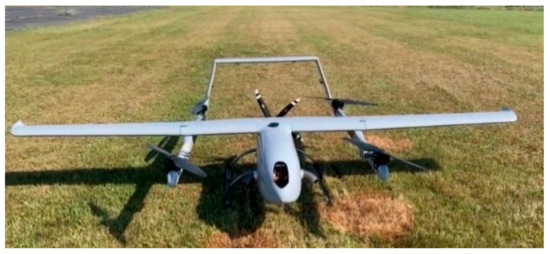
Figure 1.
Test vehicle a modified Mugin 3600 VTOL unmanned aircraft.
The aircraft in this study is a VTOL version of the Mugin 3600. This aircraft has a maximum takeoff weight of 391 N (88 lbf) and includes four electrically driven lift rotors. The aircraft is powered by a turboelectric system based on a Kingtech K-60TP turboprop and includes batteries in a series hybrid configuration [18]. The K-60TP generates electrical power by driving a brushless DC motor mechanically coupled to the output shaft from the power turbine reduction gearbox. This motor acts as a generator and creates three-phase alternating current (AC) electricity. The three-phase AC flows through a passive diode rectifier for conversion to direct current (DC) like that of a battery.
Though the aircraft is a small-scale demonstrator representative of UAM concepts, it also has potential direct application to UAS platforms. The turbine engine offers potentially quieter operation than a reciprocating engine, as well as potentially reduced vibrations and the ability to maintain power at higher altitudes. These advantages make small turbine engines an attractive option for further research. The VTOL UAS mission profile in this study, shown in Figure 2, is representative of a VTOL UAM system. The aircraft takes off vertically utilizing batteries and the turboelectric system before transitioning to forward flight. After transitioning to traditional fixed-wing flight, the aircraft utilizes only power from the turboelectric system and can use excess power produced to recharge the batteries. At the end of the mission, it lands vertically, once again utilizing power from the batteries, as needed. In this study, the aircraft flew at an altitude of 60 m above ground level (AGL), with a ground level of about 300 m at OSU, and a cruise speed of about 16 m/s.

Figure 2.
Idealized VTOL turboeletric mission profile.
3. Methodology
Johnsen et al. [18] previously laid out the rationale and analysis for the sizing and selection of the major components of the turboelectric propulsion and power system. The reader is directed to that previous work for details of the design, progressing logically from the lift rotors required for VTOL operation, propeller for horizontal flight, turbine engine for the main source of power, and then generator, battery, and electrical components for conditioning, distributing, and managing electrical current, and then, finally, the airflow required for cooling. This section compliments and completes that paper by detailing the avionics utilized and the final weight breakdowns of the flight-tested aircraft. Figure 3 shows the final power system diagram. For simplicity the diagram only shows two of the five distributed ESC and motor pairs.
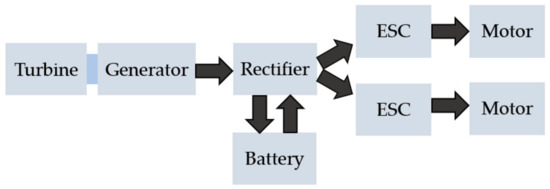
Figure 3.
Final main power system diagram.
Figure 3 shows the hybrid system architecture depicted with each arrow representing a wire. The system utilizes a series hybrid configuration, which is to say the turbine engine creates no thrust for the aircraft [19]. All thrust for the aircraft is generated by the distributed motors. Power for those motors is taken from the turbogenerator and the batteries during peak load, and during cruise, the batteries are recharged by the excess power of the turbogenerator. The nomenclature for a turboelectric hybrid system can become confusing since series hybrid and parallel hybrid (utilizing the turbine engine to create a portion of thrust) architectures are both common configurations of turboelectric systems.
3.1. Avionics and Controls Selection
Because the aircraft utilizes multiple flight modes for VTOL and forward flight, a dependable controller is required with appropriate features. During VTOL operation, lift is entirely generated actively by the propulsors; however, in forward flight, lift is generated passively by the wings. A controller is necessary to also manage the transition between VTOL and forward flight. The Pixhawk 2.1 Orange Cube flight controller was selected for this study, which supports the Ardupilot operating system with various programmable options. Table 1 includes a summary of the sensors utilized, avionics, and servo motors. There are dozens of key parameters that can be altered in the flight controller. Future work could look at optimal transition control through further refinement of the extensive parameters list and seek to improve flight safety associated with unique turboelectric power system configurations.

Table 1.
Avionics and Electronics.
3.2. Aircraft Weight Breakdown
Weight is a crucial factor for any aircraft, especially for UAS. Minimizing weight enables take-off and maximizes range and endurance, though the focus of this study is a functional aircraft. Table 2 includes the weight breakdown of the major subsystems. Notably, the empty aircraft includes the airframe, propellers, motors, wiring harness, servo motor, and avionics. The total flight-ready aircraft weight is 378 N (84.9 lbf), which is below the manufacturer specified maximum take off weight of 391 N (88 lbf). The turboelectric system includes the weights of the turboprop, system casing, rectifier, fuel pump, and ECU, as shown in Figure 4. There were components, such as the engine casing, with potential for weight reduction by a few pounds [18]. Overall these percentages are a good starting point for future aircraft. However, it’s likely that future aircraft would have a larger fuel weight and a lighter turboelectric system weight. Additionally, this technology demonstrator does not have a payload. Future aircraft would likely include a mission determine payload, which would impact the weight breakdown (battery size, fuel weight, and center of gravity).

Table 2.
Turboelectric Aircraft Weight Breakdown.
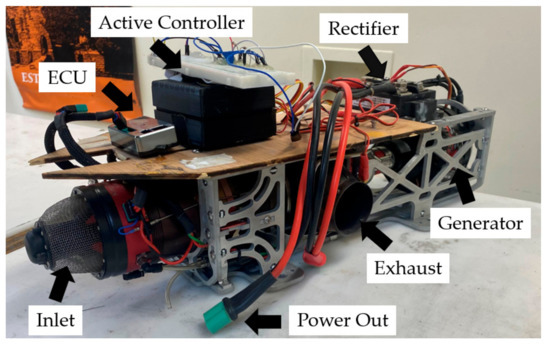
Figure 4.
Assembled Turboelectric System.
3.3. Fuel Burn
It was assumed that the turboelectric system would have the K-60TP turboprop running at full throttle during cruise (as shown later in the results section for power data). The turboprop is most fuel efficient near its maximum throttle [18]. An estimate of endurance can be calculated using the maximum fuel burn rate from the test bench [15]. Assuming 0.25 kg of reserve fuel and a single 2 min start time, the total flight endurance of the test vehicle was estimated to be around 16 min. This is a short flight time for this size vehicle, but it should be noted that aircraft weight could be reduced by removing the extra sensors and other similar components. The aircraft was designed explicitly to be a functional technology demonstrator, and a future vehicle designed for a particular mission would require a gas turbine engine with higher thermal efficiency than the inexpensive hobby-grade engine utilized in this study.
4. Results
Flight tests took place at the OSU Unmanned Aircraft Flight Station during summer 2021. To reduce risks, flights were short, but followed the mission profile shown in Figure 2. The mission consisted of a vertical takeoff, a short 2 min lap around the airfield, and then a vertical landing. The short flight test was to minimize the opportunities for failure. Prior to flight tests, ground tests verified turboelectric power system operability and flight control system functionality.
4.1. Power Data
As expected, idle voltage was lower at the end of the flight than at the beginning because of energy drained from the battery. Figure 5 shows two significant spikes of around 336 A and 390 A at around 486 s and 566 s, respectively. These spikes are due to the pilot rapidly gaining altitude after pulling out of an unintentional dive. The timing of the spikes was unexpected. The expected maximum case was during takeoff, but this was only around 240 A at the 460 s mark. Thus, the unexpected maximum occurrence was around 48% larger than at takeoff, and the most critical electric load case was during a dive recovery. It is recommended that future VTOL aircraft be designed around these dive recovery power requirements for power delivery.
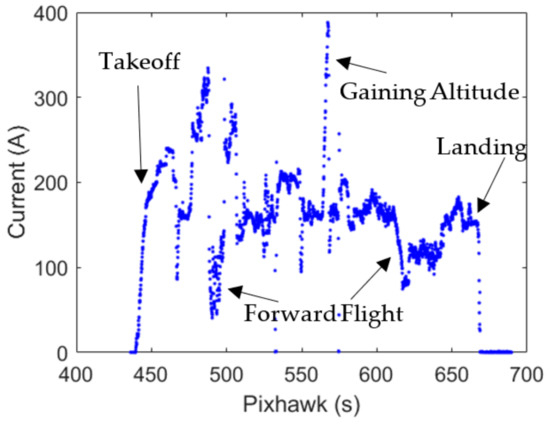
Figure 5.
Current over the course of the flight.
The main power batteries utilized in this study were 6S 12,000 mAh Graphene LiPo batteries, which had a discharge rating of 15C continuous and 30C burst [18]. This equates to a maximum current rating of 180 A continuous and 360 A burst. Based on the current data below, the batteries were sized adequately to handle the 240 A inrush current into the distributed electric motors. Without the turbogenerator the maximum load case of 390 A would have exceeded the maximum current rating of the batteries.
Figure 6 shows voltage data over that same period. The voltage data acts as an inverse to the current data of Figure 5. Whenever a large amount of current was demanded by the motors, the system voltage dropped accordingly. The authors did not anticipate the amount of voltage fluctuation. The expected peak voltage of slightly more than 48 V for a 12S system was experienced at the beginning of the data, before takeoff began. The ending voltage was around 45 V. The average voltage of the dataset is 41 V, and the mean deviation is around 2 V. The system transiently experienced a voltage dip to almost 34 V. This is almost 25% less than even the final voltage. The turbine normally keeps up the system voltage by increasing the throttle. This large voltage sag means that the turbine engine’s power output had already been exceeded and further strain was being placed on the batteries. Thus, a maximum load case with a 25% drop in voltage from the expected no load voltage is a good starting point for similar future aircraft. The power required during a pull-out could be found and thus the expected amperage of the system in that pullout could be estimated.
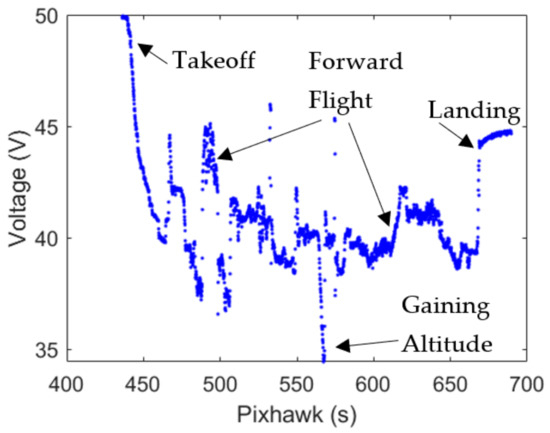
Figure 6.
Voltage over the course of the flight.
Furthermore, the voltage drop itself is of critical importance to the designers of electric hybrid aircraft, and especially UAVs. For hybrid vehicles, it is desirable to minimize the size (and thus capacity) of the battery system. This means future vehicles will experience similar substantial voltage drops. Several electronic speed controllers (ESCs) and battery management systems (BMSs) have built in protections to prevent the battery from being fully drained. Both systems often utilize a voltage cutoff point, in which any voltage below a certain threshold causes the system to think the batteries are empty. These systems do not have a sensor for the current load being placed on the batteries and will instead shut off if a lower voltage is achieved. This can cause an unintentional forced landing if the power is cutoff during a critical phase of flight, like a pull-up. Therefore, future designers should remove these voltage cutoffs until data for their aircraft configuration have been tested.
By multiplying voltage and current, the maximum instantaneous power being used by the vehicle was determined to be about 14 kW. This is consistent with the maximum estimate that was used to size the electronics (15 kW to 20 kW). However, because of the strain placed on the electrical system, the voltage drop plays a key role. To meet the power demand, the system current must rise even further, because of the lowered voltage. Thus, despite the power load being lower than expected, the maximum current case of 390 A was only just below the designed load case of 400 A [18].
4.2. Vibration and Airspeed
Figure 7 shows accelerometer data from the Pixhawk. The Pixhawk was secured to the airframe with a small wooden shelf directly underneath the wing inside the fuselage. The previously mentioned recovery from a dive was not the critical load for the aircraft, but instead, the highest acceleration was on landing. When integrated into the aircraft, the turbine engine had been mounted on a set of vibration dampeners, which helped prevent any vibration from being transmitted to the airframe. The manufacturer of the Pixhawk recommends that vibration be kept below 30 m2/s, which is around 3 g of acceleration. Based on the accelerometer data, the vibrations caused by the turbine engine were insignificant. The accelerometer data are broken into the three-component axis, with blue being x, red being y, and green being z. Figure 8 shows the airspeed data for the duration of the flight. The airspeed data along with video footage were utilized to determine the different flight states of the aircraft. Figure 8 provides context to the rest of the flight data.
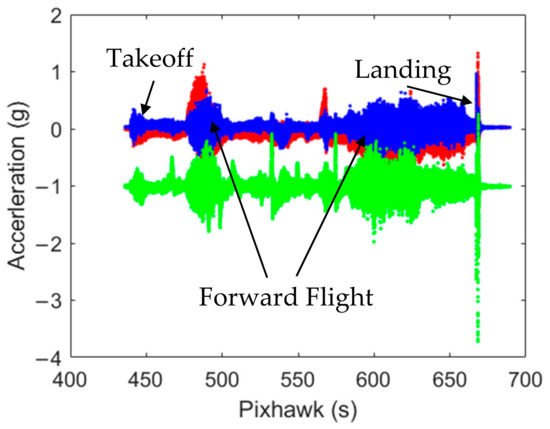
Figure 7.
Accelerometer flight data.
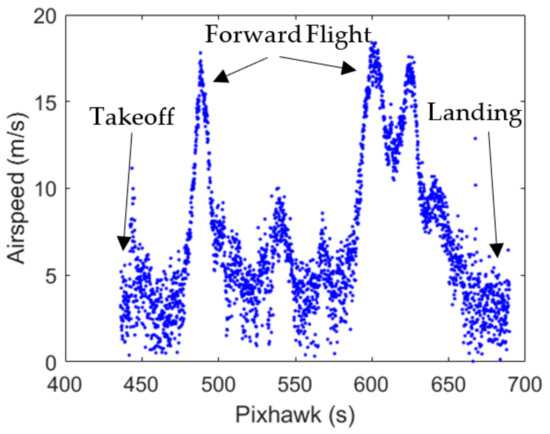
Figure 8.
Airspeed flight data.
4.3. Thermocouple Data
Heat is a major concern for the turboelectric system, primarily because of the delicate electronics. Thermocouples were used to measure temperatures inside the fuselage and on the rectifier. The results are shown in Figure 9 and Figure 10. These data were not synchronized with the Pixhawk clock because it had a separate power source and microcontroller. The startup sequence and the wait for the engine to warm up can then be seen as the temperature initially increases in Figure 9. The flight was short, lasting less than 300 s total, and did not reach a steady state. Therefore, the actual flight sequence does not begin until around the 270 s mark. From the start of the engine around 75 s to the peak temperature at 545 s, a linear growth pattern (R2 of 0.975 and 0.847 respectively) can be seen. In this case, a temperature rise to steady state should be a clear exponential function with an asymptote as a function of outside temperature. This means that the temperature had not leveled off and the system was undercooled. This was unexpected since the engine had been provided a large amount of cooling flow and heat sinks [18]. The sharp decline caused just after landing is not radiate cooling, but rather a forced-air blower used to cool the aircraft on landing. It is likely that the contribution of the radiate heat of engine was underestimated, and that the aircraft should have been better insulated against the thermal loads of the engine.

Figure 9.
Thermocouple data inside fuselage.
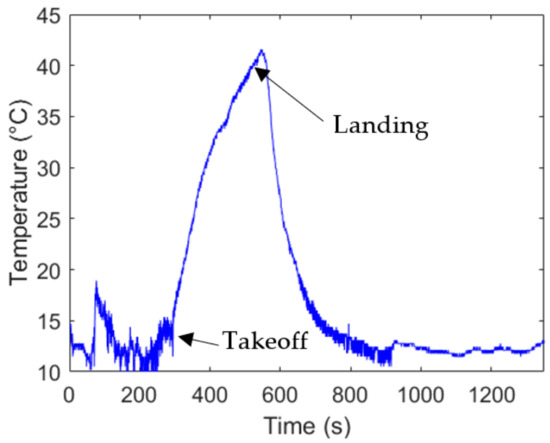
Figure 10.
Thermocouple data at the rectifier.
4.4. Far Field Acoustic Data
Far field acoustic emissions are important to UAS operating near populated areas to avoid being a nuisance. Methods to reduce acoustic emissions may include baffling, tuning engine exhaust, and employing multiple large propulsors to reduce the exhaust velocities of the main engine and propulsors. In addition to sound pressure level, it is important to manage the acoustic frequency of emissions to avoid irritation and increase dissipation. Acoustic emissions from VTOL flight tests were collected using the four half-inch microphones placed about 60 m from the vehicle to capture far-field acoustic measurements. Figure 11 shows the microphone arrangement.
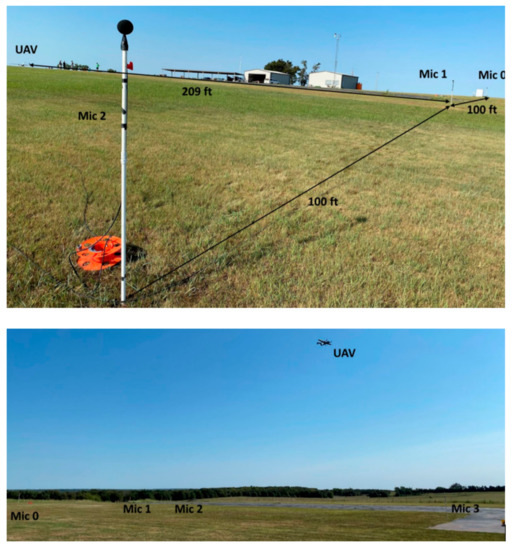
Figure 11.
Microphone configuration for VTOL flight acoustic emissions measurements.
During flight tests, acoustic measurements were collected for takeoff, hover, transition flight, and landing. Data were recorded in the time domain and postprocessed with a Fast Fourier Transform to present sound pressure level (SPL) in the frequency domain, as shown in Figure 12. The lower blue line shows ambient noise recorded at the field prior to flight tests. Ambient noise below 0 dB was due to the acoustic measurements captured below the threshold of the microphones. Peaks in the acoustic data of the microphones are due to the blade passing frequencies. However, the observed SPL throughout the flight test did not exceed the expected noise levels of similar class unmanned aircraft. The peak sound pressure level was at the low end of the human auditory range at close to 20 Hz with a 58 dB SPL. The peak auditory noise was at around 1 kHz with a 46 dB SPL.
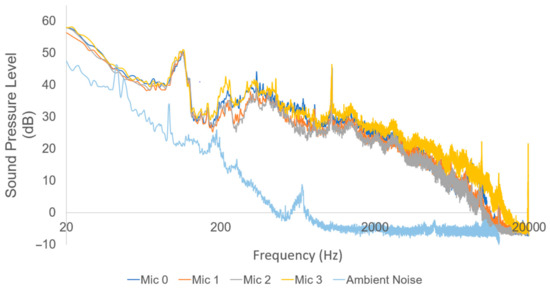
Figure 12.
Acoustic measurements from all microphones during full flight regime.
The compressor and turbine operate at such high rotational speeds that the resulting high frequencies are greater than 70 kHz, which is outside of human hearing range. The broadband noise captured during the flight test is attributed to the jet exhaust, ambient noise, propeller, and propeller slipstream interactions with the airframe. Acoustic emissions could be reduced by lowering propeller and rotor tip speeds, and by including acoustic dampening materials in the fuselage; however, these may affect system weight and performance. The aircraft currently has the largest VTOL rotor size allowable for sufficient clearance.
4.5. Uncertainty
Repeatability of flight tests and associated measurements was limited by the cost and availability of resources. This unmanned aircraft requires several people to safely operate and collect data. Higher accuracy measurements require increased cost and add weight and complexity. The conclusions formulated are based on trends in the data rather than specific values, and trends are more generalizable to other systems. Bias errors for measurements are included in Table 1 above, and are discussed in this section. For the purposes of a paper seeking to identify broad integration issues and trends, measurement uncertainty levels are sufficient to draw conclusions about trends and comparisons.
For measured current values, two 200 A Mauch power modules were utilized in parallel. The maximum bias read-out error over the full operating range provided by the manufacturer is 1.2% per module. At the maximum-recorded value of 390 A, the modules would have an error bound of 4.68 A. This sensor required manual calibration when first installed, and there could be an associated offset error. Because all measurements were taken with the same sensor, this error would be uniform for comparison purposes. Maximum loads can be distinguished, and significant comparisons can be made over the course of a flight, despite the bias error.
According to the power module manufacturer, the power module utilizes an 18:1 voltage divider to enable measures up to 14S (60 V) on the 3.3 V Pixhawk analog-to-digital converter (ADC). Because the utilized onboard Pixhawk (ADC) has a resolution of 12 bits, yielding a bias error of ±0.015 V over the operating range, there may also have been a small offset error in the voltage sensor because it required manual calibration on installation. However, since all voltages in this study used the same sensor, this offset error is negligible for the purposes of comparison and in the discussion of relative change.
The airspeed sensor (along with video footage) was used to correlate the different aircraft flight modes. Using the maximum pressure error bound of the sensor along with the definition of dynamic pressure at static conditions (the worst for the measurement) gives an error bound ±1.2 m/s. Therefore, there is a large amount of noise in the sensor at low airspeeds. As speed increases this becomes a smaller issue. At the peak airspeed of 20 m/s the error bound is ±0.035 m/s.
The thermocouple temperature sensor utilized in both locations has a maximum bias read-out error of ±2 °C across its operating range from −40 °C to 125 °C. Therefore, the real maximum temperature may have been two degrees higher, but that does not impact the observation that thermal equilibrium was not reached.
The ICM-20649 accelerometer utilized in this study was embedded inside the Pixhawk Orange Cube, and has a maximum acceleration of ±30 g with an LSB of 1024, giving a read-out error of ±0.001 g according to the manufacturers data sheet. This high level of accuracy is necessary since the flight controller uses the accelerometer for detailed navigation.
5. Discussion
5.1. Impact of Power Augmentation Battery on Reliability
The turboelectric hybrid system includes a turbine engine with a mechanical response rate measured in seconds, whereas the battery and electrical power system have a response rate measured in microseconds. Therefore, an active throttle scheme was utilized that controlled the turbine engine based on the demands of the electrical system [16,17]. A controller reads the voltage of the system and throttles the turbine engine based on whether or not the system is under load. The controller automatically detects when the system requires more or less power and throttles the turbine engine accordingly. However, the disparity in response rates can result in a situation in which electrical load transients reach an equilibrium state before the turbine. This situation can be very hazardous, generating a voltage spike from an unloaded generator that can damage electronics like the ESC, which could result in loss of the aircraft. There are several different strategies to prevent this excess power situation, such as using resistors or some other component to dissipate excess power as heat. Such an approach was used to dissipate excess energy as heat during bench testing. Unfortunately, these resistors added more than two pounds to the system weight, along with additional wires that cluttered the fuselage, making it impractical for flight.
To avoid a worst-case scenario, the battery for flight tests was sized to absorb a power surge, increasing the battery weight from 21 N (sized only for power required at take-off and landing) to about 34 N and increasing the battery capacity from a 7500 mAh battery to a 12,000 mAh battery [18]. This change increased system reliability at the expense of added weight. If the 7500 mAh minimum-sized battery had been used, the aircraft may have been recoverable in a worst-case scenario, but would have damaged batteries had turbine power been lost during a vertical climb. Based on flight data, the final battery level discharged from an initial 95% charge to around 25%, such that a smaller battery would have been insufficient for the flight. Based on power data, the rear electric motor drew between 5 kW and 6 kW in forward flight, often exceeding the turbine power produced, such that minimal power was directed to recharge the batteries, reinforcing the suggestion to use oversize batteries until the measured flight test performance is obtained.
5.2. Active Cooling Requirements for Safe Operation
Temperature-sensitive electrical components drive cooling requirements. For example, a switching circuit is employed to enable the aircraft flight modes powered by battery, turbine, or both, as well as safe power management based on battery charge level. Mode switching is desirable for a “low-noise mode,” where the aircraft operates on battery power alone to ameliorate turbine acoustic emissions. This study utilized large insulated-gate bipolar transistors (IGBTs) to switch between different battery modes. These transistors operate in a similar fashion to metal–oxide–semiconductor field-effect transistors (MOSFETs), but in this case, also offer better protection against rapid changes in electrical current. Similar to issues encountered during early development bench testing, there were IGBT failures in the switching circuitry [16]. There were a few different causes for these failures, but the primary cause was insufficient heat dissipation and temporary discharge of excess current beyond the IGBT rating. These two issues are related to high current loads that require the IGBT to dissipate more heat energy, such that a simple solution would be to use IGBTs with a higher-rated amperage or to use two IGBT’s in parallel so that each would receive half of the total current coming from the battery. However, dividing the current between two IGBTs was not effective because one momentarily received the entire battery current before the gate on the other closed. This caused the first IGBT to receive too much current and fail, subsequently causing the second IGBT to then fail. High summertime temperatures further exacerbated the issue of excessive current. During ground testing, outdoor temperatures reached 40 °C (104 °F). Temperatures inside the fuselage were even hotter. The aircraft also experienced sunlight, such that there was significant radiant heating.
Alternatively, a larger IGBT rated for 1000 A was utilized, significantly higher than the maximum expected load of about 400 A. A large heat sink was also attached to provide adequate cooling. After installation, the aircraft was taken outside for ground testing during high temperatures. After significant time (about an hour) with outdoor heating under no load, the IGBT failed such that continuity was measured across the gate, despite the gate being closed. After the aircraft was brought inside to cool, the IGBT was tested again and did not provide continuity. Therefore, elevated temperatures from the weather alone could result in a “soft-failure” in the IGBT, causing the gate to close despite no input voltage. Had the IGBT been under a load with this soft-failure state, it would have been permanently damaged. Thus, there is a clear need to use IGBTs with high temperature ratings, and to provide adequate cooling to the solid-state devices. This allows for extended aircraft ground time for a safe take-off with ambient-heated IGBTs. This will need to be addressed by future designers by either prescribing short runway loiter times that are less than a few minutes or by utilizing active cooling.
Once the aircraft is in forward motion, external cooling airflow can be utilized to manage the fuselage inside temperature. Thermocouple data showed that fuselage inside temperature was almost 30 °C hotter than ambient, even with a large amount of cooling flow based on an MFP (Mass Flow Parameter) analysis [18]. From the analysis, it is also clear the aircraft did not reach thermal equilibrium. Therefore, rather than simply increasing the hole for cooling flow, a design should separately address radiant, convective, and conductive heat sources. This could be done with a combination of ducts and thermal resistors, such as fiberglass. Despite disadvantages in weight, active cooling is recommended for key electronics during hot day operation. This active cooling could be as simple as attaching fans on electronic component heat sinks.
5.3. Battery Management for Safe Operation
The Battery Management System (BMS) monitors individual cell voltages of the main power batteries and keeps them balanced during operation. The BMS was not capable of limiting maximum battery current to a set value. When a maximum 200 A current limit was surpassed, the BMS would disconnect the battery and disallow discharge for 1 to 3 s, a concern in the event of an engine-out situation. If the turbine engine became inoperable during flight, in-flight restart was problematic. In an engine-out scenario, all power for the lift rotors would consequently come from the battery. In this situation, the batteries could exceed the current limit set on the BMS, leading to a battery power shut-off, such that no power would be available to the rotors. The resulting loss of lift could lead to vehicle loss.
The BMS was removed for flight tests, which likely prevented catastrophic loss due to engine-out during ascent, which occurred in a few flight attempts. The aircraft experienced a current exceeding 200 A from the batteries during the dive pull-out. The maximum amperage of the turbogenerator at 33 V during pull-out was around 165 A, based on the maximum measured turbogenerator power [16]. This indicates that the batteries were temporarily discharging almost 225 A and would have been disconnected by the BMS, had it been in place.
The primary risk of not including the BMS and switching circuitry would be battery damage caused by unbalanced cells, overcharging, or complete battery depletion. However, the risk of damaging the battery during initial flight tests was acceptable compared to the risk of endangering the entire vehicle. Thus, the battery was placed in parallel with the turbogenerator by connecting it to the central bus (the rectifier output terminals). However, this compromise to remove battery protections would not be a satisfactory solution for a design intended for long-duration runs, commercial use, or manned applications. Battery failures do pose a risk to the aircraft, but it is recommended to remove or disable similar safety features during the first flight tests to generate empirical data to determine aircraft system limits for safe use of BMS and switching circuitry.
An additional consideration is the implementation of multiple 12S batteries in parallel to provide redundancy. By having multiple batteries in parallel the single point failure of a singular battery cell is removed. However, increasing the number of batteries in parallel has the drawback of increasing the weight of the system and complexity.
6. Conclusions and Recommendations
Design, fabrication, and flight testing of the first-ever turboelectric VTOL unmanned aircraft provides insights for future manned and unmanned hybrid air vehicles. An experimental aircraft was constructed and flown to create recommendations for future vehicles. Time-resolved experimental flight test data provided new understanding of aircraft performance across a flight profile for field testing design decisions. A key insight from the study was the maximum electric current draw of 390 A experienced during a dive-pull-out utilizing the vertical lift motors. The maximum current draw was 48% larger than on takeoff, which was the expected maximum load case. Another insight was the need for dedicated active cooling for high-power IGBTs for flight safety. Aircraft ground testing showed that passively cooled heat sinks were inadequate to overcome elevated ambient temperatures, even with oversized IGBTs.
6.1. Power Management
Voltage and current data showed that the aircraft used slightly less peak power than expected for the design. However, the maximum power demand caused the system voltage to drop by almost 25% compared to the no-load voltage at the end of the flight. This significant drop in voltage caused the current to increase further to maintain the same power demand, nearly exceeding the designed maximum allowable of 400 A. This large voltage sag is due to minimized battery size to limit vehicle weight, uniquely constrained for electric VTOL aircraft configurations. A 30% voltage drop from the no-load voltage is a conservative preliminary estimate for battery and wire sizing in future similar hybrid gas-electric powered aircraft with a VTOL mission profile.
6.2. Thermal Management
Large, complicated UAS platforms, such as the one in this study, require significant pre-flight preparation before takeoff. During ground test setup, hot weather and the sun heated the aircraft and its electronics, even without the engine running. This substantial thermal load dictated removal of switching circuitry. The only components that failed were IGBTs, despite use of large heatsinks and no electrical load. Future hybrid aircraft that utilize IGBTs for electrical mode switching and battery management will need an active cooling solution, such as a fan and/or radiator for electronics, during ground hot-day operation.
6.3. Electrical Safety Features
The large voltage drop of a VTOL hybrid power system necessitates implementation of certain safety features. These features are designed for all-electric aircraft to protect the batteries, but they may cause the aircraft to lose all power during critical flight modes. Unlike hybrid gas-electric VTOL aircraft in an engine-out scenario, an all-electric, fixed-wing aircraft would not experience such large voltage drops, and can normally glide to a safe landing. Therefore, low voltage cutoff safety features present in an ESC or BMS may need to be disabled in future hybrid gas-electric VTOL aircraft.
6.4. Battery Sizing
Sizing batteries is a critical design decision for turboelectric power systems. A serious risk was posed to the test aircraft in this study because the rear motor pulled more power than expected in flight. Thus, battery systems should be large enough to fully power the early flight test aircraft in takeoff and flight. Battery sizing can be refined after acquiring measured in-flight aircraft and turboelectric system performance. Sizing the engine for cruise is suggested to maximize the advantages of a hybrid gas-electric power system, but this study demonstrated sizing the batteries should be done incrementally. Future hybrid gas-electric power system designs should also include a second current sensor on either the batteries or engine, to determine the contributions of each to total power generation.
6.5. Weight Estimation
The aircraft had a final flight weight of 378 N with a breakdown of 21% for the turboelectric system, 12% for the power and avionics batteries, and 7% for fuel. The weight breakdown of the turboelectric system would likely be applicable to other small-scale UAS turboelectric systems. However, this weight breakdown would depend on vehicle size. The weight of a turbine engine does not scale linearly with power, such that turboelectric systems are attractive for larger UAM aircraft.
6.6. Additional Considerations
Engine vibration is often an issue with small UAS engines. Accelerometer data confirmed that turbine engine vibrations were so small as to present no issue. The data show that similar turboelectric systems could be utilized in aircraft requiring low engine vibration, such as those carrying sensitive loads. The highest aircraft acceleration was experienced on landing and not during the dive pull-out. Thus, for VTOL aircraft, future designers should focus on airframe landing loads.
Far-field acoustic data were also recorded to evaluate the noise generated by the turboelectric aircraft in flight. The acoustic data confirmed expectations that the lifting rotors were a major noise contribution, and that the enclosed turbine engine did not significantly contribute to acoustic emissions. Peak auditory noise was around 1000 Hz with a 46 dB SPL at distance of around 210 ft.
6.7. Future Studies
Overall, this study met the objective of evaluating a functional turboelectric demonstrator VTOL aircraft. This first-ever VTOL turboelectric aircraft flight provides a starting point for the design of future aircraft, with special relevancy being placed on the power and thermal management. Future work should focus on improving the electrical system reliability and on minimizing the weight of thermal management solutions.
Author Contributions
Conceptualization, J.J., T.R. and K.R.; Data curation, T.R. and M.J.; Formal analysis, J.B. and M.J.; Funding acquisition, K.R.; Investigation, J.J., T.R., J.B. and K.R.; Methodology, J.J., J.B. and M.J.; Project administration, K.R.; Resources, K.R.; Supervision, K.R.; Validation, J.J., T.R. and J.B.; Visualization, J.J., T.R. and M.J.; Writing—original draft, J.J., T.R. and J.B.; Writing—review & editing, J.J. and K.R. All authors have read and agreed to the published version of the manuscript.
Funding
This research was funded by the Federal Aviation Administration, grant number 692M15-20-C-00012.
Institutional Review Board Statement
Not applicable.
Informed Consent Statement
Not applicable.
Data Availability Statement
Not applicable.
Acknowledgments
The authors thank Levi Ross, AJ Ross, and Mark Hartman for helping program the flight controller and piloting the aircraft and Rick Gaeta for utilizing his microphones.
Conflicts of Interest
The authors declare no conflict of interest.
References
- Armstrong, M.J.; Ross, C.A.H.; Blackwelder, M.J.; Rajashekara, K. Propulsion System Component Considerations for NASA N3-X Turboelectric Distributed Propulsion System. SAE Int. J. Aerosp. 2012, 5, 344–353. [Google Scholar] [CrossRef]
- Armstrong, M.J.; Blackwelder, M.; Bollman, A.; Ross, C.; Campbell, A.; Jones, C.; Norman, P.; Blackwelder, M.; Bollman, A.; Ross, C.; et al. Architecture, Voltage, and Components for a Turboelectric Distributed Propulsion Electric Grid; NASA: Washington, DC, USA, 2015. [Google Scholar]
- Dae Kim, H.; Felder, J.L.; Tong, M.T.; Berton, J.J.; Haller, W.J. Turboelectric Distributed Propulsion Benefits on the N3-X Vehicle. Aircr. Eng. Aerosp. Technol. 2014, 86, 558–561. [Google Scholar] [CrossRef]
- Scheidler, J.J.; Tallerico, T.F. Design, Fabrication, and Critical Current Testing of No-Insulation Superconducting Rotor Coils for NASA’s 1.4 MW High-Efficiency Megawatt Motor. In Proceedings of the 2018 AIAA/IEEE Electric Aircraft Technologies Symposium, Cincinnati, OH, USA, 9–11 July 2018. [Google Scholar] [CrossRef] [Green Version]
- Jansen, R.H.; Bowman, C.; Jankovsky, A.; Dyson, R.; Felder, J. Overview of NASA Electrified Aircraft Propulsion (EAP) Research for Large Subsonic Transports. In Proceedings of the 53rd AIAA/SAE/ASEE Joint Propulsion Conference, Atlanta, GA, USA, 10–12 July 2017. [Google Scholar]
- Misra, A. Energy Storage for Electrified Aircraft: The Need for Better Batteries, Fuel Cells, and Supercapacitors. IEEE Electrif. Mag. 2018, 6, 54–61. [Google Scholar] [CrossRef]
- Brown, A.; Harris, W.L. Vehicle Design and Optimization Model for Urban Air Mobility. J. Aircr. 2020, 57, 1003–1013. [Google Scholar] [CrossRef]
- Kühnelt, H.; Beutl, A.; Mastropierro, F.; Laurin, F.; Willrodt, S.; Bismarck, A.; Guida, M.; Romano, F. Structural Batteries for Aeronautic Applications—State of the Art, Research Gaps and Technology Development Needs. Aerospace 2021, 9, 7. [Google Scholar] [CrossRef]
- Johnson, W.; Silva, C.; Solis, E. Concept Vehicles for VTOL Air Taxi Operations. In Proceedings of the AHS Technical Conference on Aeromechanics Design for Transformative Vertical Flight, San Francisco, CA, USA, 16–19 January 2018. [Google Scholar]
- Silva, C.; Johnson, W.; Antcliff, K.R.; Patterson, M.D. VTOL Urban Air Mobility Concept Vehicles for Technology Development. In Proceedings of the 2018 Aviation Technology, Integration, and Operations Conference, Atlanta, GA, USA, 25–29 June 2018. [Google Scholar] [CrossRef] [Green Version]
- Hendricks, E.S.; Falck, R.D.; Gray, J.S.; Aretskin-Hariton, E.D.; Ingraham, D.J.; Chapman, J.W.; Schnulo, S.L.; Chin, J.C.; Jasa, J.P.; Bergeson, J.D.; et al. Multidisciplinary Optimization of a Turboelectric Tiltwing Urban Air Mobility Aircraft. In Proceedings of the AIAA Aviation 2019 Forum, Dallas, TX, USA, 17–21 June 2019; pp. 1–20. [Google Scholar] [CrossRef] [Green Version]
- Eqbal, M.; Fernando, N.; Marino, M.; Wild, G. Development of a Turbo Electric Distribution System for Remotely Piloted Aircraft Systems. J. Aerosp. Technol. Manag. 2021, 13. [Google Scholar] [CrossRef]
- Moody, K.J.; Replogle, C.J.; Rouser, K.P. Validation of Analytical Model for Turboelectric Power System for Preliminary Design Purposes. J. Eng. Gas Turbines Power 2020, 142, 081011. [Google Scholar] [CrossRef]
- Moody, K.J.; Replogle, C.; Rouser, K.P. Design, Characterization, and Integration of a Turboelectric Power System for Small Unmanned Multirotor Aircraft. In Proceedings of the AIAA Propulsion and Energy 2019 Forum, Indianapolis, IN, USA, 19–22 August 2019. [Google Scholar]
- Moody, K.J. Design, Analysis, and Integration of a Turboelectric Propulsion and Power System for Unmanned Aircraft. Master’s Thesis, Oklahoma State University, Stillwater, OK, USA, 2020. [Google Scholar]
- Runnels, T.R.; Burgess, J.M.; Johnsen, J.P.; Rouser, K.P. Experimental Study of 5-KW, 7-KW, and 13-KW Unmanned Aircraft Turboelectric Power Systems. In Proceedings of the AIAA Propulsion and Energy 2021 Forum, Virtual, 9–11 August 2021. [Google Scholar]
- Burgess, J.; Runnels, T.; Johnsen, J.; Drake, J.; Rouser, K. Experimental Comparison of Direct and Active Throttle Control of a 7 KW Turboelectric Power System for Unmanned Aircraft. Appl. Sci. 2021, 11, 10608. [Google Scholar] [CrossRef]
- Johnsen, J.P.; Runnels, T.; Burgess, J.M.; Rouser, K.P. Integration of a 7-KW Turboelectric Power System in a Vertical Take-Off and Landing Unmanned Aircraft. In Proceedings of the AIAA Propulsion and Energy 2021 Forum, Virtual, 9–11 August 2021. [Google Scholar] [CrossRef]
- Bowman, C.L.; Felder, J.L.; Marien, T.V. Turbo- and Hybrid-Electrified Aircraft Propulsion Concepts for Commercial Transport. In Proceedings of the 2018 AIAA/IEEE Electric Aircraft Technologies Symposium (EATS), Cincinnati, OH, USA, 12–14 July 2018; pp. 1–8. [Google Scholar]
Publisher’s Note: MDPI stays neutral with regard to jurisdictional claims in published maps and institutional affiliations. |
© 2022 by the authors. Licensee MDPI, Basel, Switzerland. This article is an open access article distributed under the terms and conditions of the Creative Commons Attribution (CC BY) license (https://creativecommons.org/licenses/by/4.0/).